From custom websites to enterprise products
Every business, even if it is a small family restaurant, began with something. In IT, and especially in the web, the growth rate is very high, so the history of the development of successful companies from nothing can take only some ten years, but at the same time, go through many stages, ups and downs. So it happened for KODIX , which started as a small web-studio, but came ... read further in deciphering Kirill Novikov's speech on Whale Rider , what the company came up with, what it takes to repeat success, and what are the prospects.

About the speaker: Kirill Novikov is the founder and head of the company, which has recently been called KODIX Automotive Digital and works with more than 10 car brands and more than 300 of their dealers . According to the number of clients and according to different industry ratings, this is the leading company in the field of web development for the automotive business.
')
But it was not always so.
We started back in 2008 as a typical web-studio . Many people started like this: two guys came from the street, worked somewhere and decided that they could do better. We did not want to work for my uncle, organized, and began to sell what we knew how to do. We knew how to make websites - accordingly, they sold it. We found customers somewhere, more often among friends, evaluated what needs to be done in hours, and the hours were transferred to estimates, forming the cost of the project.
We took absolutely everything , stuffed cones, got experience, and gradually replenished the team. The projects tried to do well, and, oddly enough, it was possible, therefore, word of mouth started to work.
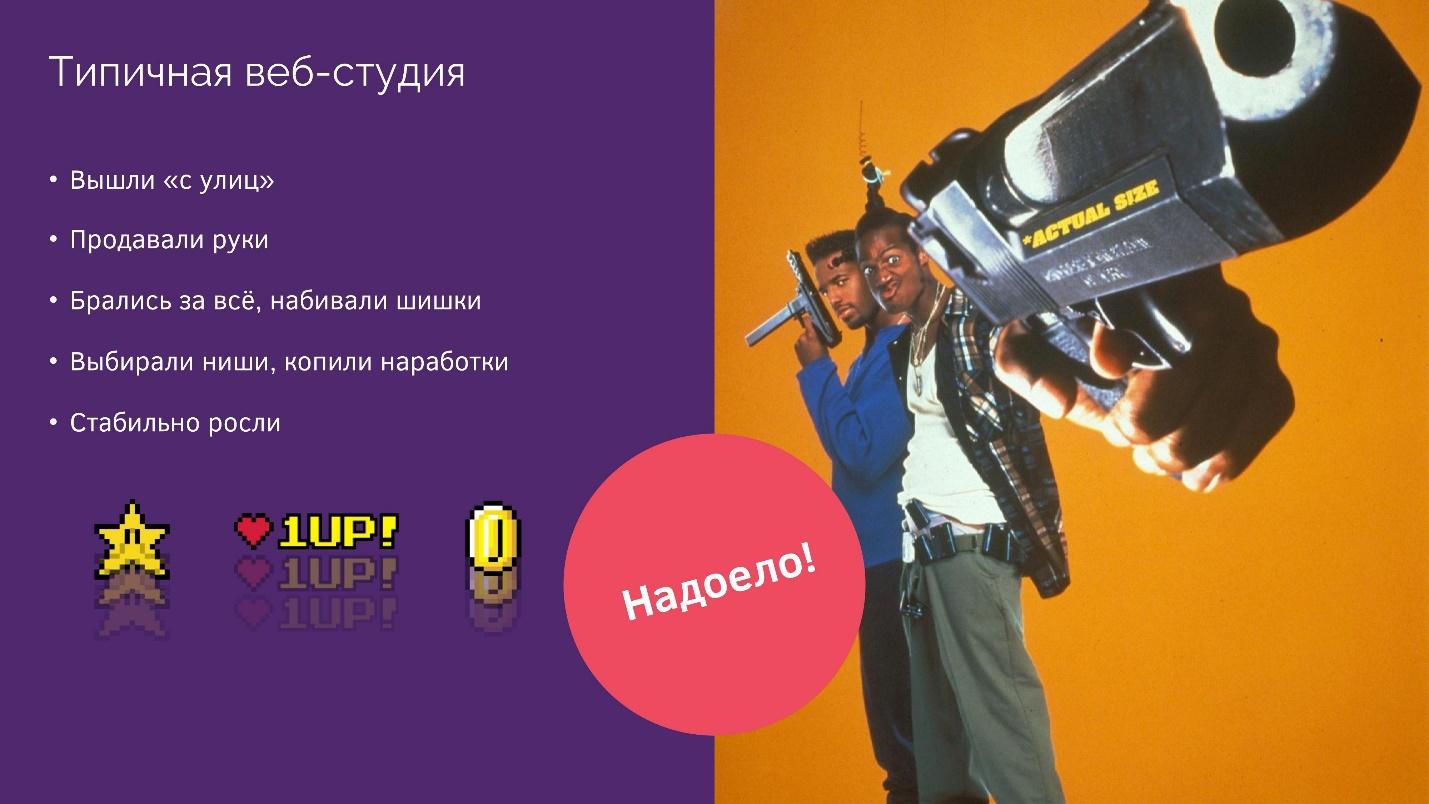
At some point, we were able to choose customers . We realized that we can allow ourselves (and it will be better for us) to concentrate in certain niches and work with certain topics, rather than undertaking everything:
We grew steadily , and everything was fine.
How did we measure our height? Like many novice studios: over the year they have completed new projects, have grown in ratings, which means they have grown. There are more employees and they have raised their salaries - remarkably, they have grown. If there is more money left after the employees were paid a salary and paid for the office, then it means that they also increased financially.
Our clients were not small, honestly, not “Horns and Hooves” - there were financial groups, already a couple of car companies, fashionable online stores. In general, mostly those with whom we wanted to work. All was good! But…
Such a misfortune! What exactly bothered?
1. Tired of working under dictation
We have gained some experience, especially in a certain niche - we understood how to do certain projects better than customers - at least, because we have already done a couple of dozen online stores of this type, and the manager who came to us has a maximum of two. We know what's best!
But in the meantime, for some reason, they failed to convey their expertise to people and make themselves believe, especially in small things. For example, we say:
But, what is most offensive, most often everything was repeated according to the same scenario: when the project is launched, after a couple of months the client comes and asks to remove the captcha, because he understood that we were right . But the work has already been done, under the dictation we have already worked! And it is absolutely tired.
2. Linear growth
Honestly, the first few years we didn’t do any financial analysis or planning. Just watched, more money or less. If they remain, it means that we are profitable in principle.
But at the junction of 2011-2012 two events occurred. One thing in our understanding is very good in terms of growth. We have twice as many employees , the studio has grown, and we moved to a new office. The second is not very good. The remaining money was not much more.
We then, using the notes on scraps of paper, e-mail, excel-tables and other testimonies, restored the picture of previous years and obtained a schedule of growth in the company's net profit over the first five years of its existence and growth in the number of employees.
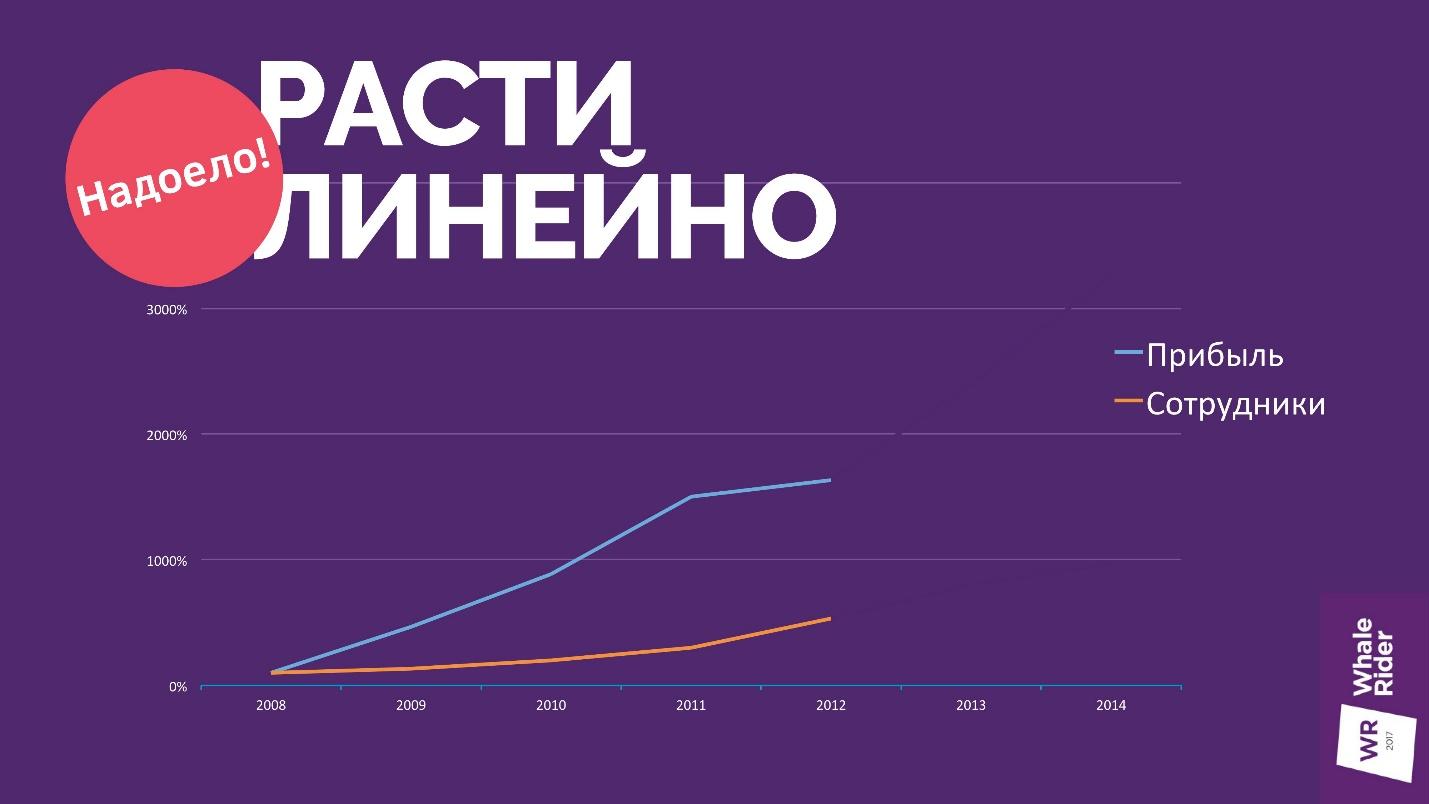
From 2008 to 2012, the growth is absolutely linear . If you simplify, then this is a consequence of the model of customized development.
Custom development is the sale of skills , that is, the sale of hands. The more projects we have taken, the more complex projects we have, that is, the more hours we have sold, the more hands we need for this. Accordingly, we are hiring new people, because we categorically failed to work with outsourcing, I don’t know why.
We hired new people, put them in the office. Eventually:
We understood that we did not want to grow. It generally lost all meaning . It became clear that in the next step we will have even more people, and we will not earn much more. Why then go ahead at all, why develop?
Further development on such a model for us then lost all meaning. At the same time, we had been reading every Zuckerberg, we learned that there is another life, that Jason Fried in Rework said that it is possible to work for the whole world with a team of 30 people, get billions and be on the Forbes list.
We really wanted to get there!
3. Work only for money
But the most important thing that we are tired of is to work exclusively for money. In those years, we did a lot of projects, invested a soul in each of them, really tried to make it better and better. But each of our projects was originally destined to die , because at best you will redo it in a redesign a few years later, and redesign is a normal and proper thing. In a not very good case, the client will leave and redo the site with someone else.
There was still the third, the most deplorable scenario, when the guys who open an online store come and believe that we will do well. We laid out in full - arguing with them, drawing, creative, running the project - and after 2-3 months the guys are closing. This is a startup, it happens.
You put the soul, and he closed ! This is absolutely tired!
Another point associated with the same. In fact, with each project we received a piece of some experience and by the end of the project we knew how to make it better, not to mention the projects that we did last year. But there is no mechanism for the rapid implementation of these changes on the completed project. You will not come to the customer and you will not say: “Give me more money, because I understood how to do better. Let us redo everything now. ”
After each such project made, we had a little money left, if we were able to earn it at all, and a little bit of shame , because we understood that we could make this project better.
We called this model “Stolen, drank, into prison” and realized that we did not want to live like this.
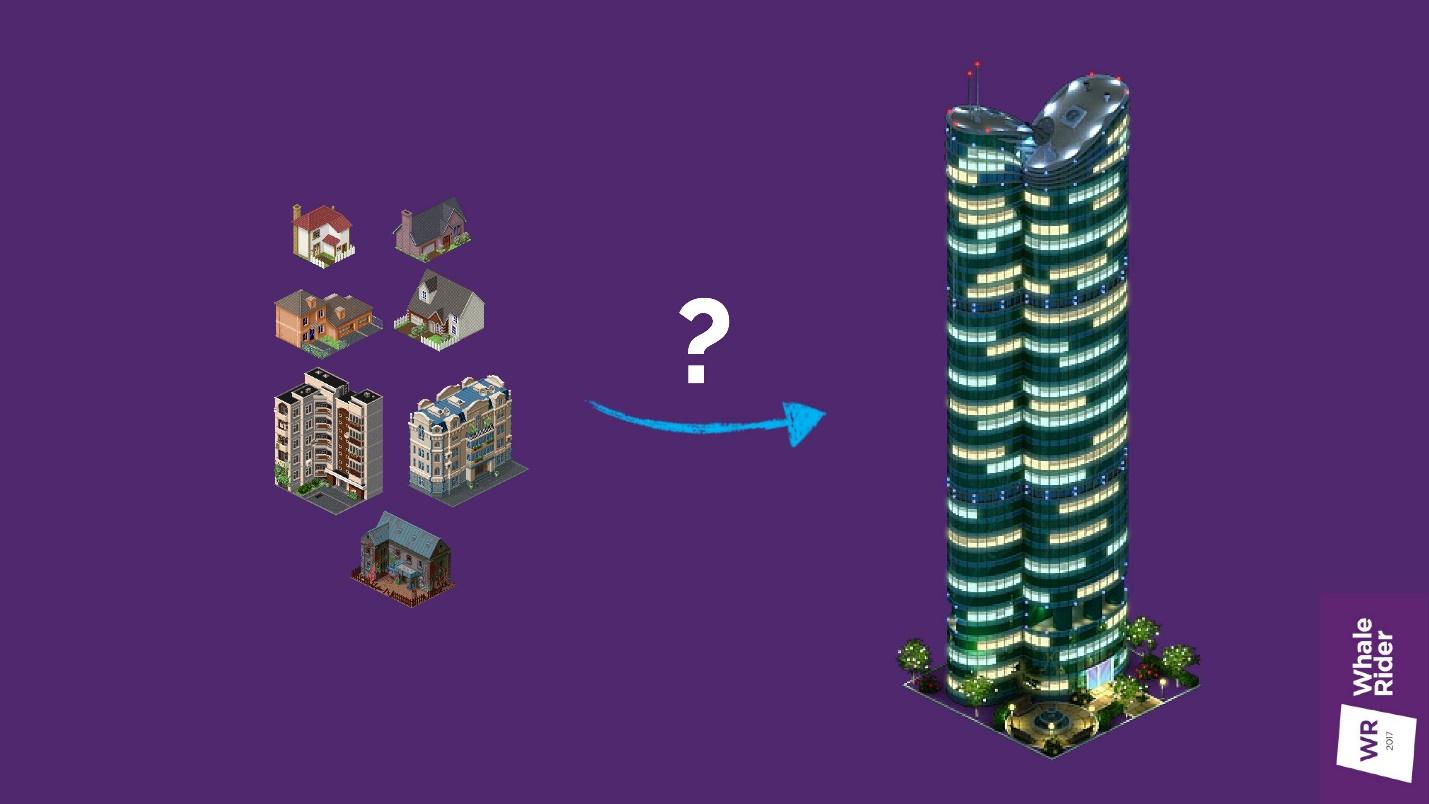
It turned out that we are building a lot of small cottages, villas, ranches and so on. They are all different - each house is beautiful in itself, but they all stand apart. We wanted to start building a huge skyscraper .
How do we stop depending on one customer? How to accumulate all your experience into something big, one? How to quickly implement change? How to make it so that we are not ashamed of our projects after they are completed? And most importantly, how to carry your vision into the world? Of course, I would also like to beat linear growth and start growing much faster than we did before, and we started trying to figure out what's stopping us.
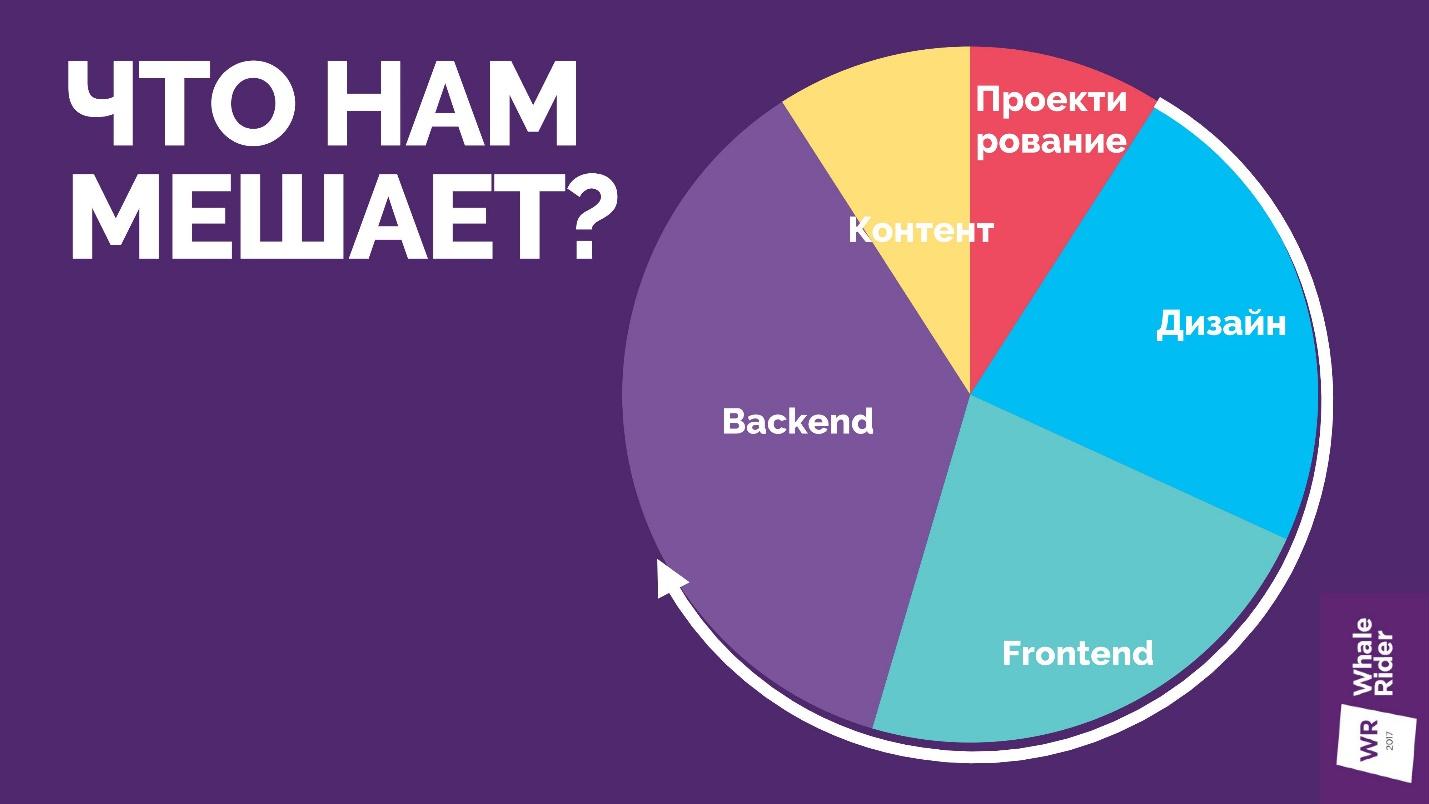
This is a model of website development that is simplified to disgrace and those stages of which it consists of an approximate division by labor costs.
It all starts in the design phase. If you are an expert in a particular industry, you are no longer engaged in designing in the format “remove the requirement - write TK”, etc. You understand how to do this, but you spend a similar amount of time trying to convince the customer that you need to do this and not in another way.
Then begins a wonderful design phase . Design in the format "customer-performer" is a pure creative. You have to guess, he has to accept, but he has a great desire to play with it himself. In this case, as a rule, the lower the rank of the manager who leads the project on the part of the customer, the more he has a burning desire to get into the project and create.
As soon as you redraw the design, it pulls all subsequent stages. You have to impose everything, integrate with the backend, even if the components are ready, and there is already a catalog, a basket, a checkout, the customer will still get into the logic and say that he needs something else. And we have to redo everything , because it's the same customer, we work for him.
And everything broke.

What we wanted to do, by and large, is to sell not what customers are used to buying, but what we would like to sell them: our vision and understanding of the ideal result .
But in the customer paradigm you are, by definition, a performer. These are the rules of the game. We realized that we need to move away:
Need to come to the sale of ready-made solutions to certain problems. The word "ready" is the key here.
There was a question how to make it.

We thought that if, despite custom development, we limit our offer, that is, we say that we sell it and only this, it looks that way and works that way, that is, we pack our expertise and experience into some finished product, this will help us.
There was still a problem to avoid creativity, that is, to get away from drawing. I mean drawing is not functional, not the implementation of certain functional tasks of the site, namely from the point of view of beauty (move fonts and forms).
In return, we could give quick integration and limited cost compared to the price of a project made to order from scratch.
Next, we had two attempts to collect something ready. The second of them was successful, the first - completely unsuccessful. I'll tell you about her first.
In the first attempt, we tried to make the perfect online clothing store in terms of our entire experience and vision. It was perfect, it was integrated very quickly (in one month), it was expensive (500,000 rubles). We gave ready-made logic, the ability to choose one of the three design options and customize it a little.
In this case, it was possible to go in other ways, for example, to make the SAS platform like Insales or Shopify. We did not go there because this niche is occupied. We also didn’t get a lot of solutions, that is, small boxes on some popular CMS, for example, 1C-Bitrix, which are laid out on the Marketplace, the client finds them there, downloads and uses them.
No, it was in principle a personalized approach to each client, but limited personalized. We guaranteed that the site will perform its tasks. It was necessary only to believe that we offer a quality thing.
But the project failed:
The result was an interesting effect. A client who initially came on a limited budget and time, that is, he wanted to save money, suddenly said: “Let's take a creative break!” - he actually found more money and an order of magnitude more actual.
We were weak willed and, of course, it went. It turned out a marketing trick - we seem to offer cheaply and quickly, as a result, we do expensive and long. And it suits everyone - everyone except us.
This is absolutely not what we were going to. Therefore, the attempt failed.
In addition, all customers had problems with the content - there is a lot of it in the online store, it is necessary to click off the entire catalog, to lay it out beautifully. While the customer does not do this, the project is not running. It is not considered complete. At this phase, all tend to blunt, and sometimes do even a year.
The blessing was the second attempt.
For a start, it is worth explaining the specifics of the auto business that there is such an interesting thing there. A car brand is a brand in itself, that is, a car manufacturer or importer into Russia, and its dealers. Dealer network includes on average from 50 to 150 dealer enterprises . These are salons, each of which is a completely independent business and, characteristically, with its own website and its own Internet marketing.
Moreover, marketing is good there, because the brand dictates the rules for how much money each dealer must spend on marketing for its sales. Moreover, what percentage should go on the Internet. These are the laws of the market.
With all this, there is a relative backwardness in terms of Internet services . These are fairly conservative sites where you can find solutions from the series: cars that are available at the dealership are lined with an excel-table, or prices are shown only by clicking on “leave a request” and so on.
This is the business of the old formation with a fairly conservative leadership, which does not want to invest in any Internet.
There is another important feature - the fact that the design standards of the brand , as such, in the first place. The creativity of each individual dealer fades into the background. Generally speaking, they should all correspond to certain guidelines.
Combining all this together, we saw in this the opportunity to realize what we wanted.

We began to look for what tasks we can solve for them, what common problems they have, with a ready solution of which we can come.
Many were completely on the surface, it was enough to examine their sites and understand what are the tasks and unresolved problems and places that are not well done from the point of view of an experienced developer. This was realized in the form of a set of services , such as, for example, a showcase of cars with cards and automatically updated prices.
Not cosmic solutions, each separately, but each of them closes a specific task .
The next thing we did was a negative experience selling the online store as a whole. We came from the back end and started selling the site as a set of ready-made solutions.
That is, in fact, began to sell the elephant in parts.
When we mastered it, we climbed deeper.
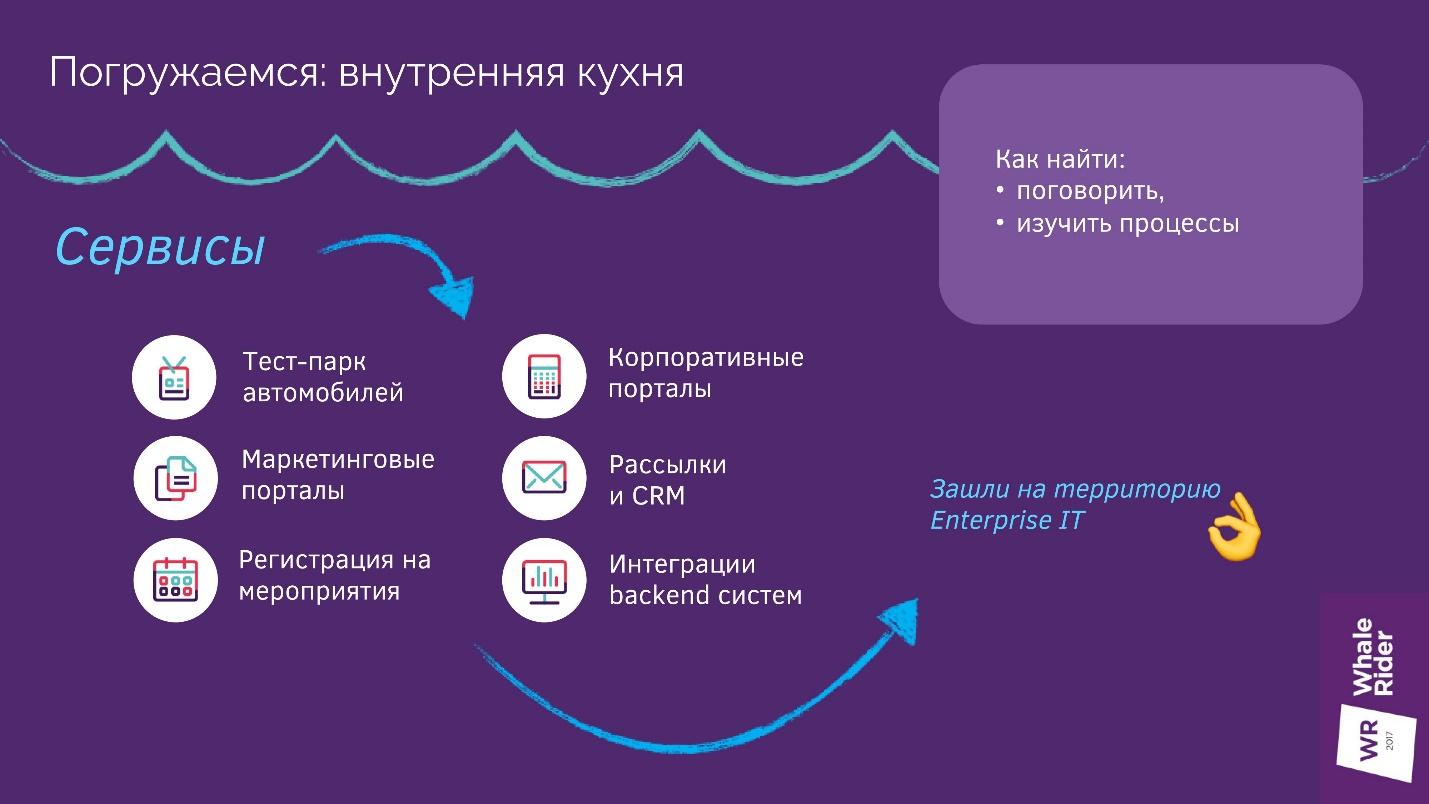
We looked inside, looked, so to speak, at the internal kitchen - we talked to the customers heart-to-heart, not within the framework of the project, and studied the processes from the inside.
It turned out that inside, in the enterprise IT territory, there is also a lot of conservative in the automotive business, and many decisions are made quite archaic.
An example is an e-mail list with an open copy to 300 recipients . Or the price editing system through a decision made on BASIC in the 80s. It became clear that there we can very cool help with the help of web-technologies that we know, and with the help of which we know how to make cool, accessible from any device things - quickly, quickly, beautifully - and present them in the form of ready-made solutions .

Finally, aerobatics are trends .
We began to study market trends, read industry publications, go to industry conferences, listen to what they say, breathe, and that, in their opinion, it will fire in this market. If you find such a solution before someone else finds it and offers it ready, then you will break the jackpot .
I’ll be blunt, until we hit the jackpot. We are in the process of searching, but I think we are close. For example, we are now launching an online payment. Online payment for a car is what the car market in Russia has been dreaming of for the last year. We will do it for them, and in the form of payment not only for the car, but also for absolutely any services, be it a service or spare parts. It will be essentially an online billing - really what they need.
I repeat, to consolidate why it worked for the automotive market.
We, frankly, 80% are quite satisfied . 80% of the automotive market is about 2.5 thousand dealers and about 30 automotive manufacturers. We are quite satisfied if they all become our customers. The remaining 20%, who need not like everyone else, will be able to find such an opportunity.
At the technical level, our product that solves a specific problem is the 1C-Bitrix modules . We independently adapt them to the design standards of a particular brand and begin to engage in direct sales of the dealer network (let me remind you of 50-150 customers).
Plus, we centrally update the content in each such module. The content in the dealer network is the same, since 150 enterprises trade in 12 identical models with the same prices, with the same images, etc.
This allowed us to proceed to the next stage - to the LTV model (lifetime value). Instead of selling an expensive installation or custom development, as we did before, we started selling a subscription .
What does a subscription give?
Naturally, no one does this as long as we keep the relevance of this product and continue to develop it, do better, as long as it meets the client's expectations.
This, on the one hand, is a plus for the client , since he receives a live product. On the other hand, this is an incentive and a plus for us , because through this we finally got that most cherished opportunity to update, roll all our accumulated experience and very quickly implement changes across all installations of our product.
For example, we figured out how to increase the conversion of applications for a car in stock - and immediately introduced it.
Everybody wins : an incentive for us, a benefit for the client.
In this case, it is the ready-made solution that works, since your confidence is ultimately projected onto the client; if you are confident in your decision, the client will be confident in it .
I want to tell a case that happened to me recently. At the Tagline awards ceremony, I went down to the bar. I love cocktails and, in order to understand whether a bar is good or not, I order Old Fashioned - this is my litmus test. I know his recipe thoroughly and usually get very hard bartenders with my comments.
The bartender makes a cocktail, and I see that he hasn't poured soda on top. And I love soda top! I say:
And you know, that Old Fashioned without soda really was, if not perfect, then close to the ideal .
If you are sure of what you offer, if you are ready to stand on it - then if not all, then many customers will buy it. This will give them confidence that they have purchased a really good product.
As a result, starting from 2012, from the turning point we have the following:
Today we are changing the way a person acquires and maintains a car. We are able to change the level of transparency and convenience for the end customer. We know that tomorrow the market will change, other rules will turn on, and we will be there and be able to help him.
It is probably interesting to see how this affected the financial side of the issue.

The graph shows our development starting in 2012, where I completed the schedule last time, over the next 5 years. The schedule of profits went up, the schedule of employees does not catch up with him, and this is good.
We realize that now is not the time for glee and euphoria. Maybe just a little bit. We are still waiting for the challenges ahead.
But the most important thing is that we represent it and we will be ready for it - I am sure!
Let's sum up.
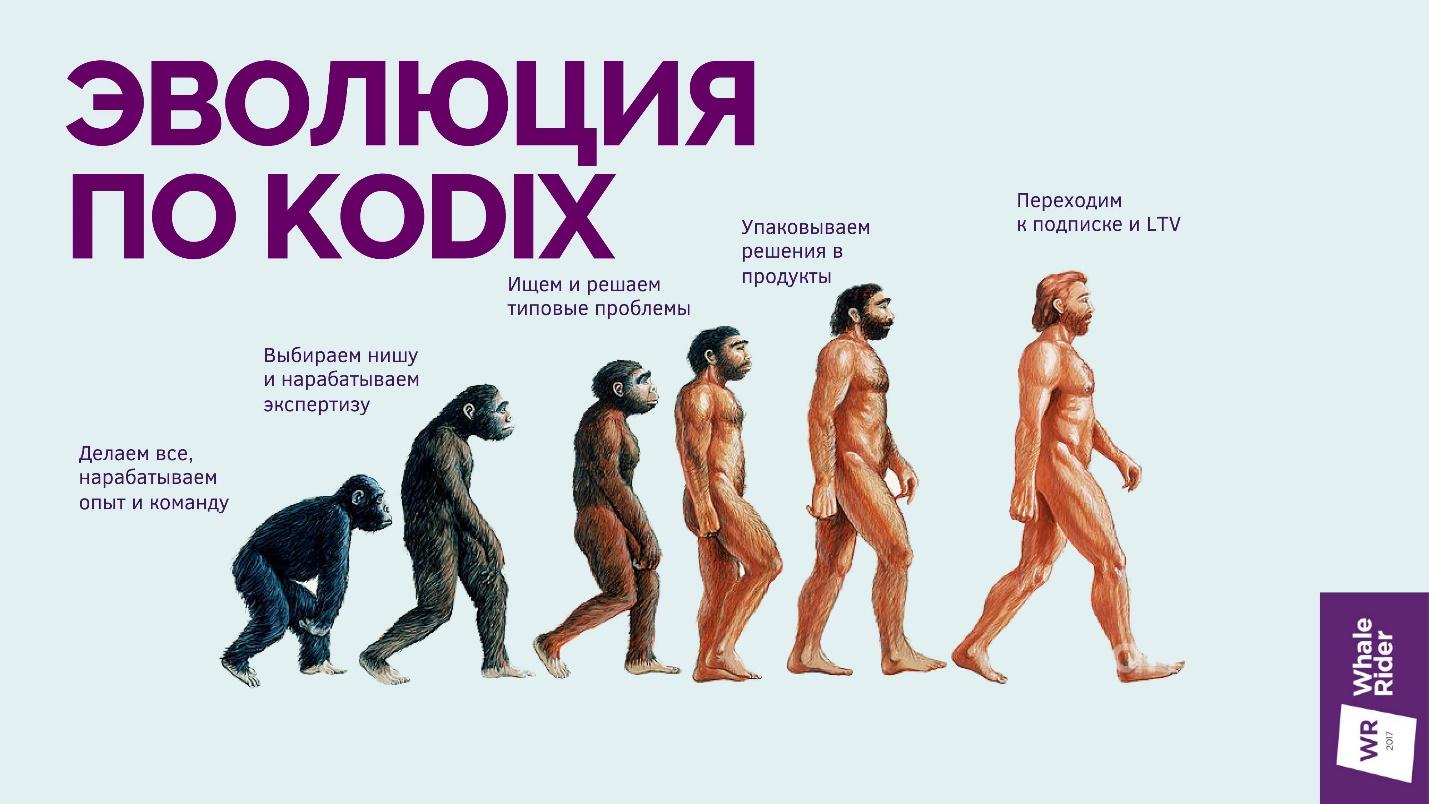
This is what Kodix evolution looks like - how we went this way, and how companies that are involved in custom development can potentially repeat it:
Usually do not tell how to repeat success. I suggest potential characteristics, the context of the niche or industry where such a model might work (in our opinion):

In general, that's all! Put it all together, find the intersection, find the industry - it is desirable that it be sufficiently capacious, and go!

About the speaker: Kirill Novikov is the founder and head of the company, which has recently been called KODIX Automotive Digital and works with more than 10 car brands and more than 300 of their dealers . According to the number of clients and according to different industry ratings, this is the leading company in the field of web development for the automotive business.
')
But it was not always so.
Start. Web studio
We started back in 2008 as a typical web-studio . Many people started like this: two guys came from the street, worked somewhere and decided that they could do better. We did not want to work for my uncle, organized, and began to sell what we knew how to do. We knew how to make websites - accordingly, they sold it. We found customers somewhere, more often among friends, evaluated what needs to be done in hours, and the hours were transferred to estimates, forming the cost of the project.
We took absolutely everything , stuffed cones, got experience, and gradually replenished the team. The projects tried to do well, and, oddly enough, it was possible, therefore, word of mouth started to work.

At some point, we were able to choose customers . We realized that we can allow ourselves (and it will be better for us) to concentrate in certain niches and work with certain topics, rather than undertaking everything:
- First, it’s easier to position and sell yourself.
- Secondly, accumulations of experience and potentially give the opportunity to make subsequent projects faster and easier.
We grew steadily , and everything was fine.
How did we measure our height? Like many novice studios: over the year they have completed new projects, have grown in ratings, which means they have grown. There are more employees and they have raised their salaries - remarkably, they have grown. If there is more money left after the employees were paid a salary and paid for the office, then it means that they also increased financially.
Our clients were not small, honestly, not “Horns and Hooves” - there were financial groups, already a couple of car companies, fashionable online stores. In general, mostly those with whom we wanted to work. All was good! But…
Tired of
Such a misfortune! What exactly bothered?
1. Tired of working under dictation
We have gained some experience, especially in a certain niche - we understood how to do certain projects better than customers - at least, because we have already done a couple of dozen online stores of this type, and the manager who came to us has a maximum of two. We know what's best!
But in the meantime, for some reason, they failed to convey their expertise to people and make themselves believe, especially in small things. For example, we say:
- Let's not make a captcha in the checkout, it will kill the conversion. The task is to sell, and captcha is not needed.
- No, make me a captcha, otherwise trash orders will go to my managers, and they will not sell, but will engage in incomprehensible filtering work. I don't need it, do as I said.
But, what is most offensive, most often everything was repeated according to the same scenario: when the project is launched, after a couple of months the client comes and asks to remove the captcha, because he understood that we were right . But the work has already been done, under the dictation we have already worked! And it is absolutely tired.
2. Linear growth
Honestly, the first few years we didn’t do any financial analysis or planning. Just watched, more money or less. If they remain, it means that we are profitable in principle.
But at the junction of 2011-2012 two events occurred. One thing in our understanding is very good in terms of growth. We have twice as many employees , the studio has grown, and we moved to a new office. The second is not very good. The remaining money was not much more.
We then, using the notes on scraps of paper, e-mail, excel-tables and other testimonies, restored the picture of previous years and obtained a schedule of growth in the company's net profit over the first five years of its existence and growth in the number of employees.

From 2008 to 2012, the growth is absolutely linear . If you simplify, then this is a consequence of the model of customized development.
Custom development is the sale of skills , that is, the sale of hands. The more projects we have taken, the more complex projects we have, that is, the more hours we have sold, the more hands we need for this. Accordingly, we are hiring new people, because we categorically failed to work with outsourcing, I don’t know why.
We hired new people, put them in the office. Eventually:
- Operating expenses increase : on the office, on the secretaries, coffee cookies, bookkeeping, HR and other people who do not participate in the production process. Profitability in itself falls as non-production expenses grow.
- Efficiency decreases . We couldn’t find an exact explanation, but it turned out that the same project, which we could put together at the beginning of our journey with our small cohesive team of five people in three months, now took at least six. Probably affected by the complexity of communication or the complexity of the transfer of knowledge within the team.
We understood that we did not want to grow. It generally lost all meaning . It became clear that in the next step we will have even more people, and we will not earn much more. Why then go ahead at all, why develop?
Further development on such a model for us then lost all meaning. At the same time, we had been reading every Zuckerberg, we learned that there is another life, that Jason Fried in Rework said that it is possible to work for the whole world with a team of 30 people, get billions and be on the Forbes list.
We really wanted to get there!
3. Work only for money
But the most important thing that we are tired of is to work exclusively for money. In those years, we did a lot of projects, invested a soul in each of them, really tried to make it better and better. But each of our projects was originally destined to die , because at best you will redo it in a redesign a few years later, and redesign is a normal and proper thing. In a not very good case, the client will leave and redo the site with someone else.
There was still the third, the most deplorable scenario, when the guys who open an online store come and believe that we will do well. We laid out in full - arguing with them, drawing, creative, running the project - and after 2-3 months the guys are closing. This is a startup, it happens.
You put the soul, and he closed ! This is absolutely tired!
Another point associated with the same. In fact, with each project we received a piece of some experience and by the end of the project we knew how to make it better, not to mention the projects that we did last year. But there is no mechanism for the rapid implementation of these changes on the completed project. You will not come to the customer and you will not say: “Give me more money, because I understood how to do better. Let us redo everything now. ”
After each such project made, we had a little money left, if we were able to earn it at all, and a little bit of shame , because we understood that we could make this project better.
We called this model “Stolen, drank, into prison” and realized that we did not want to live like this.

It turned out that we are building a lot of small cottages, villas, ranches and so on. They are all different - each house is beautiful in itself, but they all stand apart. We wanted to start building a huge skyscraper .
Time to change
How do we stop depending on one customer? How to accumulate all your experience into something big, one? How to quickly implement change? How to make it so that we are not ashamed of our projects after they are completed? And most importantly, how to carry your vision into the world? Of course, I would also like to beat linear growth and start growing much faster than we did before, and we started trying to figure out what's stopping us.

This is a model of website development that is simplified to disgrace and those stages of which it consists of an approximate division by labor costs.
It all starts in the design phase. If you are an expert in a particular industry, you are no longer engaged in designing in the format “remove the requirement - write TK”, etc. You understand how to do this, but you spend a similar amount of time trying to convince the customer that you need to do this and not in another way.
Then begins a wonderful design phase . Design in the format "customer-performer" is a pure creative. You have to guess, he has to accept, but he has a great desire to play with it himself. In this case, as a rule, the lower the rank of the manager who leads the project on the part of the customer, the more he has a burning desire to get into the project and create.
As soon as you redraw the design, it pulls all subsequent stages. You have to impose everything, integrate with the backend, even if the components are ready, and there is already a catalog, a basket, a checkout, the customer will still get into the logic and say that he needs something else. And we have to redo everything , because it's the same customer, we work for him.
And everything broke.

What we wanted to do, by and large, is to sell not what customers are used to buying, but what we would like to sell them: our vision and understanding of the ideal result .
But in the customer paradigm you are, by definition, a performer. These are the rules of the game. We realized that we need to move away:
- from the sale of clean hands - naturally, we have already left from this;
- even selling yourself as an expert in some field.
Need to come to the sale of ready-made solutions to certain problems. The word "ready" is the key here.
There was a question how to make it.

We thought that if, despite custom development, we limit our offer, that is, we say that we sell it and only this, it looks that way and works that way, that is, we pack our expertise and experience into some finished product, this will help us.
There was still a problem to avoid creativity, that is, to get away from drawing. I mean drawing is not functional, not the implementation of certain functional tasks of the site, namely from the point of view of beauty (move fonts and forms).
In return, we could give quick integration and limited cost compared to the price of a project made to order from scratch.
Next, we had two attempts to collect something ready. The second of them was successful, the first - completely unsuccessful. I'll tell you about her first.
Attempt No. 1. E-commerce
In the first attempt, we tried to make the perfect online clothing store in terms of our entire experience and vision. It was perfect, it was integrated very quickly (in one month), it was expensive (500,000 rubles). We gave ready-made logic, the ability to choose one of the three design options and customize it a little.
In this case, it was possible to go in other ways, for example, to make the SAS platform like Insales or Shopify. We did not go there because this niche is occupied. We also didn’t get a lot of solutions, that is, small boxes on some popular CMS, for example, 1C-Bitrix, which are laid out on the Marketplace, the client finds them there, downloads and uses them.
No, it was in principle a personalized approach to each client, but limited personalized. We guaranteed that the site will perform its tasks. It was necessary only to believe that we offer a quality thing.
But the project failed:
- First, it didn’t work to sell it quickly . Everyone had to explain, communicate, show examples and prove that we are cool guys.
- Secondly, it also took time to explain how their store would differ in design from the box we offer.
The result was an interesting effect. A client who initially came on a limited budget and time, that is, he wanted to save money, suddenly said: “Let's take a creative break!” - he actually found more money and an order of magnitude more actual.
We were weak willed and, of course, it went. It turned out a marketing trick - we seem to offer cheaply and quickly, as a result, we do expensive and long. And it suits everyone - everyone except us.
This is absolutely not what we were going to. Therefore, the attempt failed.
In addition, all customers had problems with the content - there is a lot of it in the online store, it is necessary to click off the entire catalog, to lay it out beautifully. While the customer does not do this, the project is not running. It is not considered complete. At this phase, all tend to blunt, and sometimes do even a year.
The blessing was the second attempt.
Attempt number 2. Autobusiness
For a start, it is worth explaining the specifics of the auto business that there is such an interesting thing there. A car brand is a brand in itself, that is, a car manufacturer or importer into Russia, and its dealers. Dealer network includes on average from 50 to 150 dealer enterprises . These are salons, each of which is a completely independent business and, characteristically, with its own website and its own Internet marketing.
Moreover, marketing is good there, because the brand dictates the rules for how much money each dealer must spend on marketing for its sales. Moreover, what percentage should go on the Internet. These are the laws of the market.
With all this, there is a relative backwardness in terms of Internet services . These are fairly conservative sites where you can find solutions from the series: cars that are available at the dealership are lined with an excel-table, or prices are shown only by clicking on “leave a request” and so on.
This is the business of the old formation with a fairly conservative leadership, which does not want to invest in any Internet.
There is another important feature - the fact that the design standards of the brand , as such, in the first place. The creativity of each individual dealer fades into the background. Generally speaking, they should all correspond to certain guidelines.
Combining all this together, we saw in this the opportunity to realize what we wanted.

We began to look for what tasks we can solve for them, what common problems they have, with a ready solution of which we can come.
Many were completely on the surface, it was enough to examine their sites and understand what are the tasks and unresolved problems and places that are not well done from the point of view of an experienced developer. This was realized in the form of a set of services , such as, for example, a showcase of cars with cards and automatically updated prices.
Not cosmic solutions, each separately, but each of them closes a specific task .
The next thing we did was a negative experience selling the online store as a whole. We came from the back end and started selling the site as a set of ready-made solutions.
- Do you have problems a, b, c, d?
- Yes there is.
- Let's take one of our ready-made solutions, each of which is quickly installed and is inexpensive, we put together a website.
That is, in fact, began to sell the elephant in parts.
When we mastered it, we climbed deeper.

We looked inside, looked, so to speak, at the internal kitchen - we talked to the customers heart-to-heart, not within the framework of the project, and studied the processes from the inside.
It turned out that inside, in the enterprise IT territory, there is also a lot of conservative in the automotive business, and many decisions are made quite archaic.
An example is an e-mail list with an open copy to 300 recipients . Or the price editing system through a decision made on BASIC in the 80s. It became clear that there we can very cool help with the help of web-technologies that we know, and with the help of which we know how to make cool, accessible from any device things - quickly, quickly, beautifully - and present them in the form of ready-made solutions .

Finally, aerobatics are trends .
We began to study market trends, read industry publications, go to industry conferences, listen to what they say, breathe, and that, in their opinion, it will fire in this market. If you find such a solution before someone else finds it and offers it ready, then you will break the jackpot .
I’ll be blunt, until we hit the jackpot. We are in the process of searching, but I think we are close. For example, we are now launching an online payment. Online payment for a car is what the car market in Russia has been dreaming of for the last year. We will do it for them, and in the form of payment not only for the car, but also for absolutely any services, be it a service or spare parts. It will be essentially an online billing - really what they need.
I repeat, to consolidate why it worked for the automotive market.
- First, there are design standards , which excludes creative, function generates form.
- The value lies in the fact that we come with a guaranteed solution to a particular problem.
- For this guaranteed solution, 80% of the market are ready to donate their Wishlist.
We, frankly, 80% are quite satisfied . 80% of the automotive market is about 2.5 thousand dealers and about 30 automotive manufacturers. We are quite satisfied if they all become our customers. The remaining 20%, who need not like everyone else, will be able to find such an opportunity.
Technical details
At the technical level, our product that solves a specific problem is the 1C-Bitrix modules . We independently adapt them to the design standards of a particular brand and begin to engage in direct sales of the dealer network (let me remind you of 50-150 customers).
Plus, we centrally update the content in each such module. The content in the dealer network is the same, since 150 enterprises trade in 12 identical models with the same prices, with the same images, etc.
This allowed us to proceed to the next stage - to the LTV model (lifetime value). Instead of selling an expensive installation or custom development, as we did before, we started selling a subscription .
What does a subscription give?
- First, it is a low entry threshold .
- Secondly, you can try and refuse if you do not like it.
Naturally, no one does this as long as we keep the relevance of this product and continue to develop it, do better, as long as it meets the client's expectations.
This, on the one hand, is a plus for the client , since he receives a live product. On the other hand, this is an incentive and a plus for us , because through this we finally got that most cherished opportunity to update, roll all our accumulated experience and very quickly implement changes across all installations of our product.
For example, we figured out how to increase the conversion of applications for a car in stock - and immediately introduced it.
Everybody wins : an incentive for us, a benefit for the client.
In this case, it is the ready-made solution that works, since your confidence is ultimately projected onto the client; if you are confident in your decision, the client will be confident in it .
I want to tell a case that happened to me recently. At the Tagline awards ceremony, I went down to the bar. I love cocktails and, in order to understand whether a bar is good or not, I order Old Fashioned - this is my litmus test. I know his recipe thoroughly and usually get very hard bartenders with my comments.
The bartender makes a cocktail, and I see that he hasn't poured soda on top. And I love soda top! I say:
- Listen, and soda?
- No, he's perfect!
- What are you, I do not pour soda? I'm crying to you!
- Not in my bar!
And you know, that Old Fashioned without soda really was, if not perfect, then close to the ideal .
If you are sure of what you offer, if you are ready to stand on it - then if not all, then many customers will buy it. This will give them confidence that they have purchased a really good product.
What happened
As a result, starting from 2012, from the turning point we have the following:
- We have ceased to depend on one customer . Instead of realizing the whims of a single customer, we listen to the entire market and its trends.
- We have an opportunity to carry our vision , our idea of the ideal customer experience to the world.
- We implement changes very quickly . As soon as we learn something new, we have the opportunity to introduce it to everyone. Thus, all end users, that is, you and I, car buyers, benefit from this.
- The most important thing is that we, as a company, finally saw our goal and really are changing the industry. We got the opportunity to do it.
Today we are changing the way a person acquires and maintains a car. We are able to change the level of transparency and convenience for the end customer. We know that tomorrow the market will change, other rules will turn on, and we will be there and be able to help him.
It is probably interesting to see how this affected the financial side of the issue.

The graph shows our development starting in 2012, where I completed the schedule last time, over the next 5 years. The schedule of profits went up, the schedule of employees does not catch up with him, and this is good.
We realize that now is not the time for glee and euphoria. Maybe just a little bit. We are still waiting for the challenges ahead.
- Already, we understand that we need to change the structure of the team .
- Already now we understand that, perhaps, we will have to change the technology on which we work at some point, because it will be rested against certain limitations.
- The economy of the market can change entirely - the reduction takes place in all sectors .
But the most important thing is that we represent it and we will be ready for it - I am sure!
Let's sum up.

This is what Kodix evolution looks like - how we went this way, and how companies that are involved in custom development can potentially repeat it:
- We began by doing everything in a row, selling our physical ability to create websites, gaining experience, creating a team, perfecting our processes.
- Then we chose a niche and developed a certain expertise in it.
- After that, we found certain typical problems, solved them.
- Packed solutions into finished products.
- We started selling by subscription model (LTV).
Where to repeat success
Usually do not tell how to repeat success. I suggest potential characteristics, the context of the niche or industry where such a model might work (in our opinion):
- Independent points of sale (independent businesses), geographically distributed. Each of the points of sale must sell directly its services and move itself as a brand.
- They should have a strong headline and their own internet marketing.

In general, that's all! Put it all together, find the intersection, find the industry - it is desirable that it be sufficiently capacious, and go!
This article is a transcript of one of the best performances at Whale Rider 2017 , a conference on project management and entrepreneurship in IT as part of the RIT ++ festival. The next festival will be held at the end of May, and we can already talk about some interesting applications:
- Vitaly Leonov (Avito) with the report “ Developers — also clients ” about the experience of introducing a product approach in platform teams .
- Andrei Tokach (Pavlov's Dog) with a story about his own experience as a project manager for creating new product interfaces .
- Dmitry Shchipachev (Finch) promises to open, how to make 20 projects in 10 years and not go broke .
View the full list of applications for WhaleRider or the entire RIT ++ , choose the most significant ones for yourself, and this is a link to booking tickets , the price of which will still rise.
Source: https://habr.com/ru/post/353898/
All Articles